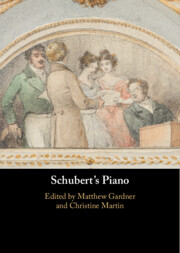Book contents
- Schubert’s Piano
- Schubert’s Piano
- Copyright page
- Contents
- Figures
- Tables
- Music Examples
- Notes on Contributors
- Acknowledgements
- Abbreviations and Conventions
- Introduction
- Part I The Piano in Schubert’s World
- Part II Instruments and Performance
- 5 Schubert and the Viennese Piano
- 6 Performing Simultaneous Triplets and Dotted Rhythms in Schubert’s Piano Music
- 7 Viennese Pianoforte Treatises as a Reflection of Schubert’s Pianistic Audience
- Part III Sound and Musical Imagery
- Part IV Understanding Schubert’s Writing for the Piano
- Select Bibliography
- Index
6 - Performing Simultaneous Triplets and Dotted Rhythms in Schubert’s Piano Music
from Part II - Instruments and Performance
Published online by Cambridge University Press: 31 August 2024
- Schubert’s Piano
- Schubert’s Piano
- Copyright page
- Contents
- Figures
- Tables
- Music Examples
- Notes on Contributors
- Acknowledgements
- Abbreviations and Conventions
- Introduction
- Part I The Piano in Schubert’s World
- Part II Instruments and Performance
- 5 Schubert and the Viennese Piano
- 6 Performing Simultaneous Triplets and Dotted Rhythms in Schubert’s Piano Music
- 7 Viennese Pianoforte Treatises as a Reflection of Schubert’s Pianistic Audience
- Part III Sound and Musical Imagery
- Part IV Understanding Schubert’s Writing for the Piano
- Select Bibliography
- Index
Summary
Schubert’s piano music and songs contain several examples where triplets are notated alongside dotted rhythms. Editors, writers and performers disagree about the performance of these rhythms, which exist in keyboard music from at least the late Baroque to the early twentieth century. This chapter surveys evidence from the long nineteenth century, drawing on previous literature and introducing new lines of enquiry. It situates the problem as it applies to Schubert within a broader view of the meaning of notation through the eighteenth and nineteenth centuries, suggesting that many aspects of rhythmic notation remained unfixed during the period.A broader range of evidence than previously considered is documented, including contradictory passages from performance tutors and other literature, anomalous notation in the music of several composers, different versions of Schubert’s works and rhythmic alignment in a range of sources. A study of engraving practice offers insight into the rhythmic presentation of published sources. Finally, early recordings demonstrate that rhythmic performance continued to be controversial into the twentieth century.Because of the scant and sometimes contradictory nature of the evidence, it is not possible to arrive at definitive solutions to the performance problems. Nevertheless, this chapter draws some distinctive conclusions from the sources.
Keywords
- Type
- Chapter
- Information
- Schubert's Piano , pp. 116 - 135Publisher: Cambridge University PressPrint publication year: 2024

